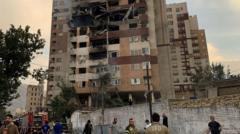An analysis of the impact of Israel's airstrikes on Iran's proxy groups, particularly Hezbollah, and the broader context of ongoing Middle East tensions.
Israel's Strikes Reveal Weakened Iranian Military Network Amid Regional Turmoil

Israel's Strikes Reveal Weakened Iranian Military Network Amid Regional Turmoil
A critical look at Israel's recent military actions against Iranian proxies and their implications for regional security and the balance of power in the Middle East.
In a striking development, Israel's recent military strikes against Iranian interests highlight a significant shift in the capabilities and responses of the so-called "Axis of Resistance," a coalition of militias supported by Iran. This network, which Iran has cultivated over decades to challenge Israeli influence in the region, appears to be in a state of considerable decline, according to military analysts.
The Israeli attacks, executed on Friday, illustrate the diminishing power of these proxy groups, particularly Hezbollah, which has long stood as one of Iran's most formidable partners in the region. Following the strikes, Hezbollah issued a statement condemning the action but notably refrained from promising any military retaliation. Experts suggest this lack of aggressive response indicates that Hezbollah, still reeling from a previous conflict with Israel, is currently unable to mount an effective defense or counterattack.
"The Axis of Resistance is not completely dismantled, but its effectiveness has been severely weakened, resulting in a posture of vulnerability rather than aggression," commented Mohanad Hage Ali, a prominent analyst from the Carnegie Middle East Center in Beirut. This evolution is particularly alarming for Iran, which relied on these groups to push back against Israeli incursions and to foster regional deterrence.
Iran has historically invested vast resources in building this network of militias, which includes Hamas, Hezbollah, the Houthis in Yemen, and various factions in Iraq. These groups were instrumental in carrying out attacks against Israel, especially following the escalation of violence after the Hamas-led strikes in October 2023, and Israel's subsequent invasion of Gaza. Yet, the narrative has shifted, with Israel effectively targeting these actors in ways that suggest a new phase of military engagement.
Hezbollah, which suffered significant losses during its prolonged conflict with Israel, faces intense scrutiny and criticism within Lebanon. This has resulted in a loss of political capital, as many Lebanese citizens hold the group accountable for their country’s current predicaments stemming from warfare. The remnants of its influence are waning as the group grapples with a fragile reconstruction process, compounded by a multibillion-dollar debt burden following extensive destruction in the conflict.
The situation in the Middle East remains fraught with tension as Israel's military maneuvers continue to challenge the operational capacity and strategic ambitions of Iran's proxy forces. The shifting balance of power raises questions about future engagements and the regional dynamics as these armed factions confront their greatest existential threats.
The Israeli attacks, executed on Friday, illustrate the diminishing power of these proxy groups, particularly Hezbollah, which has long stood as one of Iran's most formidable partners in the region. Following the strikes, Hezbollah issued a statement condemning the action but notably refrained from promising any military retaliation. Experts suggest this lack of aggressive response indicates that Hezbollah, still reeling from a previous conflict with Israel, is currently unable to mount an effective defense or counterattack.
"The Axis of Resistance is not completely dismantled, but its effectiveness has been severely weakened, resulting in a posture of vulnerability rather than aggression," commented Mohanad Hage Ali, a prominent analyst from the Carnegie Middle East Center in Beirut. This evolution is particularly alarming for Iran, which relied on these groups to push back against Israeli incursions and to foster regional deterrence.
Iran has historically invested vast resources in building this network of militias, which includes Hamas, Hezbollah, the Houthis in Yemen, and various factions in Iraq. These groups were instrumental in carrying out attacks against Israel, especially following the escalation of violence after the Hamas-led strikes in October 2023, and Israel's subsequent invasion of Gaza. Yet, the narrative has shifted, with Israel effectively targeting these actors in ways that suggest a new phase of military engagement.
Hezbollah, which suffered significant losses during its prolonged conflict with Israel, faces intense scrutiny and criticism within Lebanon. This has resulted in a loss of political capital, as many Lebanese citizens hold the group accountable for their country’s current predicaments stemming from warfare. The remnants of its influence are waning as the group grapples with a fragile reconstruction process, compounded by a multibillion-dollar debt burden following extensive destruction in the conflict.
The situation in the Middle East remains fraught with tension as Israel's military maneuvers continue to challenge the operational capacity and strategic ambitions of Iran's proxy forces. The shifting balance of power raises questions about future engagements and the regional dynamics as these armed factions confront their greatest existential threats.


















